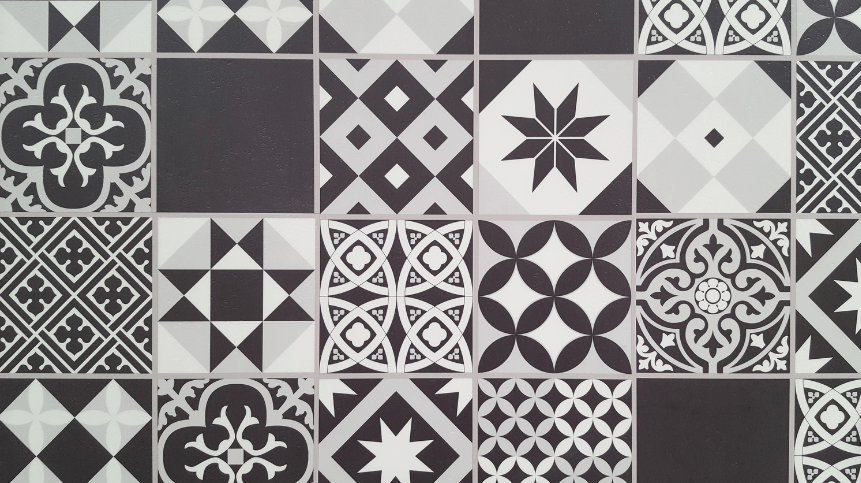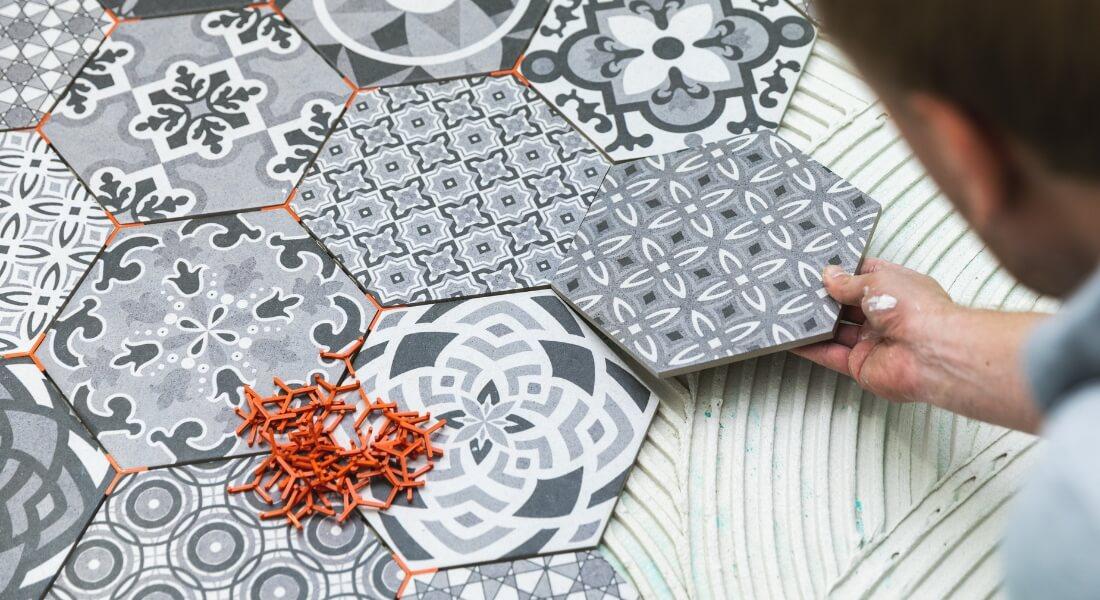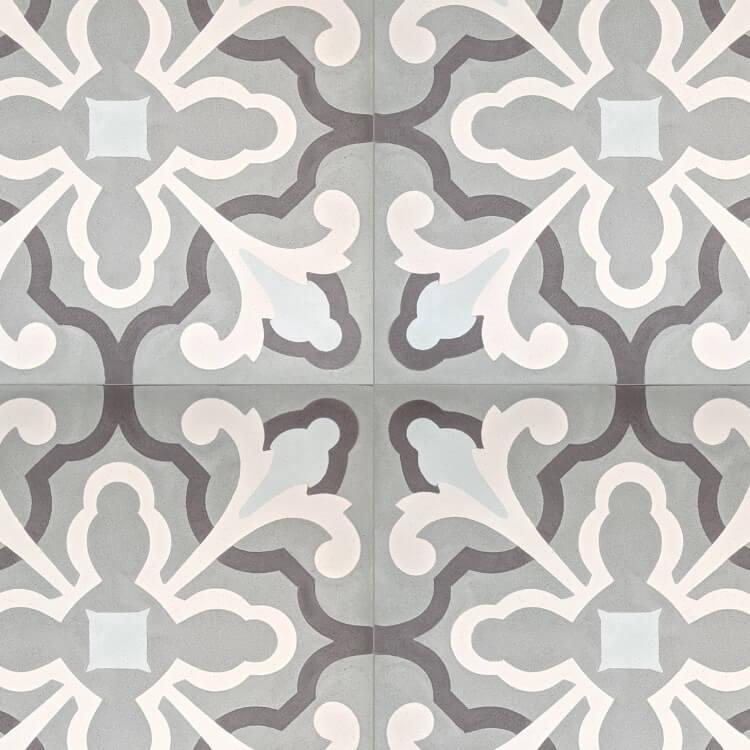As Technical Specifications Manager for FILA UK, Martin Ballard knows a thing or two about encaustic tiles. With his expertise, we have put together this post to keep them looking flawless from the day that they are installed. As encaustic tiles are a source of customer interest, we thought some FAQs would help first before getting into Martin’s cleaning, maintenance and protection advice. Read on as we cover some of the most common questions on patterned clay tiles, plus tips to keep them looking clean and stain-free.
Three FAQs on encaustic tiles
Do encaustic tiles need sealing?
Encaustic tiles are porous, so sealing them properly first is essential to reduce natural absorption and maintain the desired appearance. It will be easier to maintain the surface if you use the recommended care system – see step 3 to find out more about this.
Can I use any cleaner for encaustic tiles?
Absolutely not; strong off-the-shelf products can potentially reduce the surface’s lifespan, so acid cleaners should never be used. Instead, a neutral cleaning product is key to ensuring the surface stays clean. You should also never use too much water on encaustic tiles.
Can encaustic tiles be used in a public building?
Yes, of course, and they will look amazing. In fact, the encaustic tiled floors are a significant feature of Westminster Palace in London. Whether a restaurant or hotel, they’re an extremely durable choice as long as they’re sealed correctly and well-maintained.

How to keep encaustic tiles clean and stain-free
1. Apply a pre-grouting treatment
Tools you will need: a brush for small areas or a fleece applicator for much larger spaces.
When it comes to installing encaustic clay tiles, the first step is to apply a pre-grouting protective agent. PRW200 is the one for the job to protect the surface from grout; just make sure the tiles are dust-free before applying the product. Not only will this treatment make cleaning after laying simple, but it’s very easy to use. Simply apply the product in a nice even coat. Take care to also press into those joints, but it doesn’t need to be heavily layered; too much, and the sealer could start pooling.
Consult the technical data sheet if you’re unsure, and make sure to carry out a patch test prior to application to check for any changes in colour.
2. Carry out an initial clean with a professional cleaner
Tools you will need: a brush or abrasive pad and a sponge or a mop and bucket for smaller spaces. A sponge fleece applicator, a rotary machine and an aqua vac for larger areas.
Next, it’s time to remove the grout residues from the encaustic tiles, and for this, we recommend FILA’s PS87 PRO. This professional cleaner needs to be diluted in water at 1:5 (1 litre of product in 5 litres of water), applied to the surface and left for a short while (4 or 5 minutes will allow for contact time). Next use a brush or a rotary machine, depending on the size of the project. Agitating the surface will help to break up soils, reduce wash time and increase efficiency. You don’t need to press on too hard; light pressure will do until you start to see the encaustic tiles become clean.
If you didn’t pre-treat the tiles first, the grout may be hard to remove, so it’s always best to start with this step. Once you’re confident all grout residues have been cleaned, remove any remaining product using an Aquavac or a sponge. NB. PS87 PRO will not damage the tiles or grout lines.
Always refer to the technical data sheet if you’re unsure for complete application instructions.

3. Apply an anti-stain protector
Tools you will need: a brush for a small floor area or wall or fleece applicators for larger areas and more control of how the sealer is applied.
Step 3 involves sealing the tiles after washing (usually 24-48 hours after the tiles are fully dry and clean). We recommend FILA’s sealer MP90 ECO XTREME for its green properties and its ability to protect kiln-fired tiles. When you’re ready to apply the product, tip it into a suitable container like a measuring jug, and put the cap back onto the bottle. Apply a nice, even coat across the surface and along the grout joints. You’ll start to see the colour of the tiles darkening as the sealer settles. For very absorbent materials, you can apply two coats of this sealer, leaving a 20-minute interval in between each. This is not a filming product.
After 2 hours, the surface can be walked on, and after 24 hours, full water and stain protection will be activated. After 24 hours, once the surface is dry, you can then test the sealer by applying a small drop of water onto one of the tiles. You’ll notice how the water reacts to the material and forms a puddle. This tells us that the tiles have been properly cleaned and the sealer applied correctly. The tiles should now be fully protected from stains, and liquids can be cleaned straight off without leaving any water marks behind.
For complete application instructions, see the technical data sheet.
4. Maintaining encaustic tiles long-term
Tools you will need: a cloth and mop for general cleaning or a brush, pad, cloth, rotary machine and aqua vac for extraordinary maintenance.
Once your tiles are fully protected and clean, long-term maintenance counts, and we recommend using a pH-neutral cleaner like CLEANER PRO. This will allow you to keep encaustic tiles clean without the risk of damage. This pH-neutral cleaner is also great for surfaces that are sensitive to acids. For the basic cleaning of tiles, dilute CLEANER PRO at 1:200 or for more difficult dirt, dilute this cleaner at 1:30. For particularly stubborn stains, we recommend NOSPOT, NORUST, ZEROSIL and SR95, or we welcome you to contact our technical team for further advice.
Our technical data sheet provides the complete application instructions for CLEANER PRO.
5. Keep in mind the precautions
Due to the delicate nature of Encaustic tiles, some precautions are needed to minimise the risk of damage. Never use rough or abrasive materials like wire brushes, and always stick to the recommended tile-cleaning products to remove ingrained dirt and cement deposits.
Interested in encaustic tiles? Reach out to FILA’s technical team
Thank you for reading our post; we hope it has helped. If you have any questions, we’d love to hear from you! Alternatively, why not leave Martin a comment below? He likes to read them. As encaustic tiles are one of our specialities, feel free to reach out. Thanks again.
